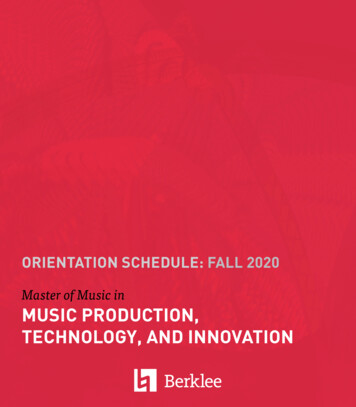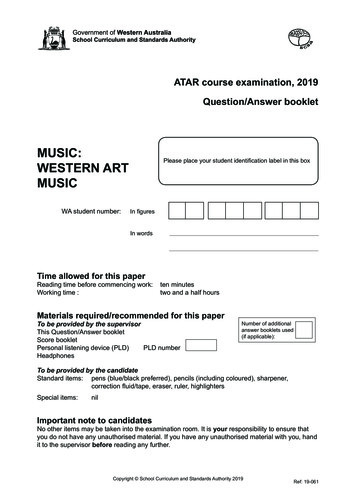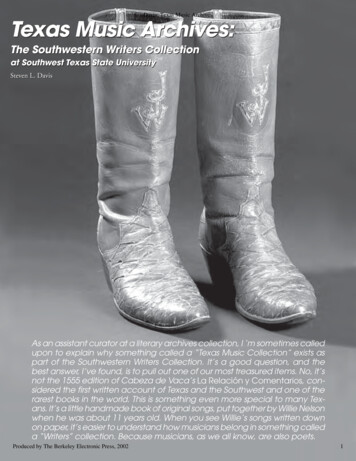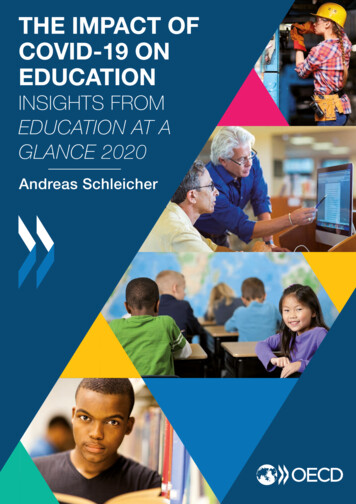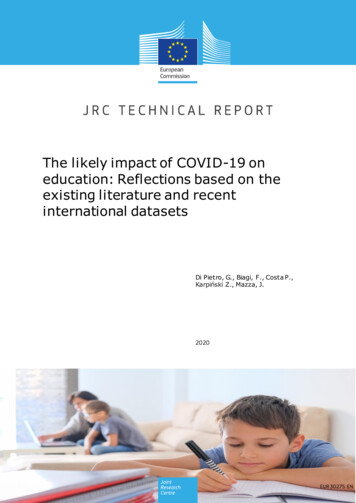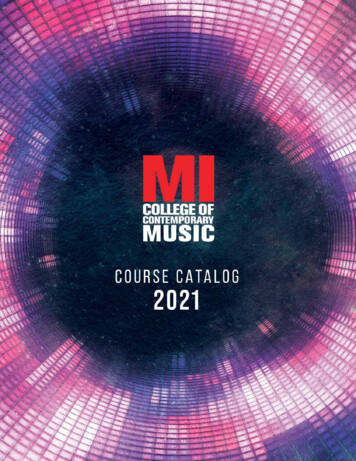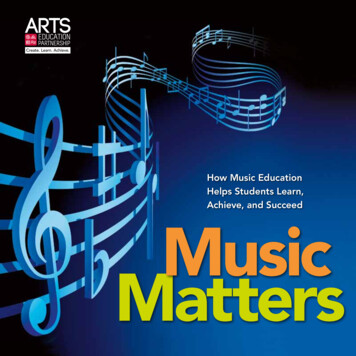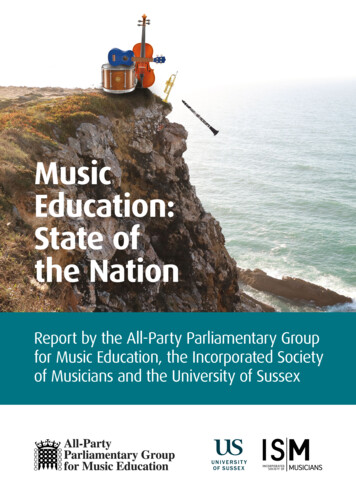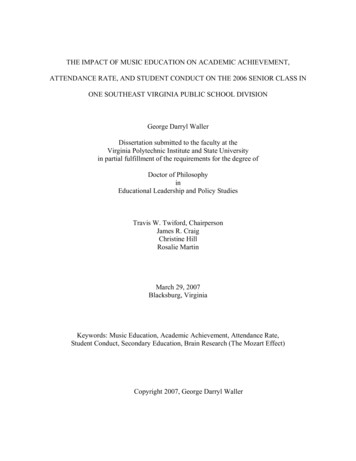
Transcription
THE IMPACT OF MUSIC EDUCATION ON ACADEMIC ACHIEVEMENT,ATTENDANCE RATE, AND STUDENT CONDUCT ON THE 2006 SENIOR CLASS INONE SOUTHEAST VIRGINIA PUBLIC SCHOOL DIVISIONGeorge Darryl WallerDissertation submitted to the faculty at theVirginia Polytechnic Institute and State Universityin partial fulfillment of the requirements for the degree ofDoctor of PhilosophyinEducational Leadership and Policy StudiesTravis W. Twiford, ChairpersonJames R. CraigChristine HillRosalie MartinMarch 29, 2007Blacksburg, VirginiaKeywords: Music Education, Academic Achievement, Attendance Rate,Student Conduct, Secondary Education, Brain Research (The Mozart Effect)Copyright 2007, George Darryl Waller
THE IMPACT OF MUSIC EDUCATION ON ACADEMIC ACHIEVEMENT,ATTENDANCE RATE, AND STUDENT CONDUCT ON THE 2006 SENIOR CLASS INONE SOUTHEAST VIRGINIA PUBLIC SCHOOL DIVISIONGeorge Darryl WallerChairperson: Travis W. Twiford, Ed. D(ABSTRACT)For several decades music educators have proposed that the study of music has asignificant impact on student academic achievement, attendance rates, and student conduct. In anera of higher student and teacher accountability, increasing budget cuts, the federal No ChildLeft Behind Act (NCLB), and stringent state standards of learning, a number of educators haveargued that education in music can boost test scores, attendance, attitudes toward school, reducediscipline referrals, and increase overall academic achievement.The purpose of this study was to quantify general education claims by examining highschool academic achievement data, attendance rates, and student conduct of the 2006 graduatingclass in one Southeast Virginia school division.In addition, this study briefly explores the impact that music education has on the humanbrain and on academic achievement at the elementary school and secondary school levels.Moreover, influences that integrating music has on academic achievement in general educationcourses, arts integration programs, and elements of an effective music education program areexplored. Specific research studies provide evidence to support key concepts and the need foradditional research.The research design includes the independent variables: subject and number of yearsenrolled in formal music courses or no formal music courses, gender, ethnicity, and enrollment
in formal music courses or no formal music courses in high school, grades nine through twelve.The dependent variables include: academic achievement as measured by grade twelve weightedcumulative grade point average (GPA), attendance rate as measured by the number of absencesin grade twelve, and student conduct as measured by the number of discipline referrals in gradenine through grade twelve.Four research questions were used to explore academic achievement, attendance rate, andstudent conduct with regard to music or no music courses taken in grades nine through twelve.Ethnicity and gender were reported using the common dependent variables among participants inthree populations – entire study population, music population, and non music population.Conclusions were based upon sophisticated statistical tests including descriptive andinferential statistics, correlations, analysis of variance (ANOVA), and regression statistics. Thesetests confirmed the four research questions and null hypotheses that music students out performtheir non music counterparts in academic achievement, attendance rate, and student conduct.Although the studied school division does not distinguish between excused and unexcusedabsences, music students had fewer days absent than non music students.iii
DEDICATIONThis dissertation is dedicated to the memory of my father, George Alexander Waller, whodied July 11, 2004 after a long and courageous battle against Amyotrophic Lateral Sclerosis(ALS) or Lou Gehrig’s disease. It was through my father’s example of unending strength andlove that a promise to see this project to completion was ever possible.Second, to my mother, Jean Faye Brickhouse Waller, who has provided me withcountless examples of how to be the primary caregiver through good and tough times; and for theguidance, assurance, and words of wisdom that all things are possible.Third, to my two younger brothers, Brian and Stephen, and the members of my extendedfamily, I dedicate this work to you. Knowing that you all believed in me has made this journeyall the more worthwhile.Most importantly, I dedicate this dissertation to the glory of God who has opened andwill continue to open many doors for growth and opportunity throughout my education andprofessional career.Finally, I dedicate this dissertation to the individuals and families that have or areexperiencing the devastation of ALS. We must search for strength within one another to sustainthe ideals on which our afflicted loved ones stood so that the lessons they taught us will remainconstant in our daily lives. Reach for the cure!iv
ACKNOWLEDGEMENTWhen a person begins the arduous task of taking on a study of this magnitude, it isdifficult to project the number of people that influence the journey. So many people shape yourperson and your work. Therefore, let me mention only a few.First, let me thank my chairperson Dr. Travis W. Twiford and his secretary Linda Jonesfor your undying partnership in this endeavor. Many times the journey seemed rocky but youboth were always there to help smooth the pathway. Dr. Twiford, you are an incredible man andeducator! Thank you!To the members of my committee: Dr. James Craig, Dr. Christine Hill, and Dr. RosalieMartin, words could never express the warmth and friendship you all have shared in making thisstudy stronger, meaningful, and approachable. I agree, the study is long and takes more than justa few hours to read and comprehend, but I believe we have offered valuable informationregarding the state of music education in the United States.Second, I would like to thank the members of my 2003 Hampton Roads cohort for yourencouragement, motivation, and constant perseverance during our four years together. You allare some of the most dedicated and talented individuals I have met along the journey.Third, my highest gratitude is extended to the members of Hilton Christian Church. Yourwords of encouragement, prayers, and frequent banter were enough to sustain anyoneundertaking this monumental task.Finally, my heartfelt appreciation is given to my secretary, Shirley Barrow; my coworker, Patricia Franklin, Supervisor of Art; and all my colleagues and teachers for vacations,shared presentations and more in order to complete this journey.Thanks to you all!v
TABLE OF ABLE OF CONTENTS.viLIST OF TABLES.xiiLIST OF FIGURES.xxiCHAPTER 1. .1INTRODUCTION TO THE STUDYIntroduction of the Study .1Context for Inquiry.1Music Education in the United States. .10Statement of the Problem.14Conceptual Model.15Significance of the Study.19Purpose of the Study.22Research Questions.22Definition of Terms.23Limitations and Delimitations of the Study.27Organization of the Study.29CHAPTER 2. . 31REVIEW OF RELATED LITERATUREReview of the Literature. .31vi
The Impact of Music on the Brain – The Mozart Effect.32Historical Perspective.32Promoting Music and the Mozart Effect. .34The Controversy Begins. . .36Using Mozart or Not Using Mozart. .41The Mozart Effect and Preschool Children. . .42The Mozart Effect and Background Music in Public Schools. .45Expanding the Mozart Effect – A Summary. . .48Music Education and Elementary School Academic Achievement . .52Using Piano Instruction for Increased Academic Achievement . .53Music Instruction and At-Risk Preschool Children .60Elementary School Instrumental Music Instruction andAcademic Achievement. . .68Music, Academic Achievement, and Gender Control. . .73Background Music and Academic Achievement in Writing. .74Summary. . .79Music Education and Secondary School Academic Achievement. . .80Participation in Music and Athletic Activities. .80Instrumental Music and Academic Achievement. . 82Music Participation and Grade 12 Core Academic Subjects. .83Music Participation, Acquisition of Complex Academic andSocial Skills, and Academic Transfer. . .93Summary. . .95vii
Integrating Music Education in Core Subjects and Academic Achievement. 96Start With Arts Program (SWAP.) .97Artful Learning: A School Reform Model. . 99Integrating Music into Social Studies. 104The Impact of Music on Social, Cognitive, and Academic Skillsof Disabled Students. . .105Summary. . 106Elements of an Effective Music Education Program that ImpactAcademic Achievement. .110Parental Involvement. . .110Barriers to Family Involvement. . . . 119Peer Influence and Success in Life. . .122Summary. .124Chapter Summary. .125CHAPTER THREE. 127METHODOLOGYMethodology. . .127Setting.128Population . 130Research Design .133Data Collection Procedures. .137viii
Instrumentation. . 139Grade Twelve Weighted Cumulative Grade Point Average. . .139Number of Absences in Grade Twelve. . .141Number of Discipline Referrals in Grade Nine through Grade Twelve.142Threats to Internal and External Validity. . . .142Data Analysis. . . . .144Chapter Summary. . . 146CHAPTER FOUR. . .148FINDINGS AND RESULTSIntroduction. . .148Background Information. . . .148Research Questions . . 149Data Collection Procedures . . . . .150Instrumentation . . . . .151Data Analysis Techniques . .151Descriptive Statistics, Correlations, Analysis of Variance (ANOVA), and Regression.152Grade Twelve Weighted Cumulative Grade Point Average .156Entire Study Population .157Music Population .175Non Music Population . 187Number of Absences in Grade Twelve . .196Entire Study Population . .198Music Population .215ix
Non Music Population . 228Number of Discipline Referrals in Grade Nine through Grade Twelve .237Entire Study Population . .238Music Population .255Non Music Population .269Data Tables for Each Research Question .280Chapter Summary .287CHAPTER FIVE . 288SUMMARY, CONCLUSIONS, DISCUSSION, AND RECOMMENDATIONSIntroduction and Summary . .288Limitations and Delimitations 290Discussion of Findings . . .292Summary 307Conclusions and Implications for Practice . 309Recommendations for Practice 312Recommendations for Future Study . .313Research Reflections . . 315REFERENCES. .316APPENDIX .329Institutional Review Board DocumentsCertificate of Completion – Training in Human Subjects Protection . .329Initial Review Application .330Request for Exempt Status . .340x
Approval for Exempt Status . .343Sampled School Division DocumentsApplication for Research Authorization . .344Research Authorization Approval .346eSIS Report Request Form . 347Scatter Plots .348Grade Twelve Weighted Cumulative Grade Point AverageEntire Study Population .348Music Population .351Non Music Population .354Number of Absences in Grade TwelveEntire Study Population .357Music Population .360Non Music Population .363Number of Discipline Referrals in Grade Nine through Grade TwelveEntire Study Population .366Music Population .369Non Music Population .372Resume .375xi
LIST OF TABLESTablePage1Mean Scores of Males by Condition .442Mean Task Scores and Standard Deviations for Keyboard (N 34) andNo Music (N 28) Groups . .563Two-Factor (Group, Time) Analyses of Variance for Puzzle Solving,Block Building, and Pictorial Tasks .584Mean Gain Scores (Pretest – 8 Months) for Keyboard (N 34) andNo Music (N 28) Groups . .595Mean Ohio Proficiency Test Scores for String and Non-String Students .696Music Subjects as Predictors of Achievement in Grade 12 Mathematics . . .867Music Subjects as Predictors of Achievement in Grade 12 English . . 868Music Subjects as Predictors of Achievement in Grade 12 Biology .879Mean Percentage Scores of Achievement in Grade 12 Mathematics, English, andBiology, for the 2001 Cohort, for Four Groups: All Students; Participants of BandGrade 11; Participants of String Grade 11; Participants of Choir Grade 11;Participants of Composition Grade 11 . .8910Effect Sizes in Comparison to “All Students” Mean Scores Using Cohen’s d(Group Mean Differences in Standard Deviations) and as Correlation Coefficients r.All Group Comparisons are with the “All Students” Means Scores .89xii
11Mean Percentage Scores of Achievement in Grade 12 Mathematics, English, andBiology, for the 2002 Cohort, for Four Groups: All Students; Participants of BandGrade 11; Participants of String Grade 11; Participants of Choir Grade 11;Participants of Composition Grade 11 .9012Effect Sizes in Cohen’s d (Group Mean Differences Divided by StandardDeviation) and as Correlation Coefficients r. All Group Comparisons are withThe All Students Mean Scores . 9113Mean Percentage Scores of Achievement in Grade 12 Mathematics, English, andBiology, for the 2003 Cohort, for Four Groups: All Students; Participants of BandGrade 11; Participants of String Grade 11; Participants of Choir Grade 11;Participants of Composition of Grade 11 . 9114Effect Sizes in Cohen’s d (Group Mean Differences in Standard Deviations) andas Correlation Coefficients r: All Group Comparisons are with the All StudentsMean Scores . 9215Results of Four Research Studies Relating to Emotionally Disturbed Students,Juvenile Delinquents and Disadvantaged Students, English Language Learners,and the Effects of Music as Reinforcement for Education/Therapy Objectivesas Featured in Deasy (2000) Critical Links: Learning in the Arts and StudentAcademic and Social Development 10716Student Enrollment by Ethnicity for Sampled School Division . .12917Ethnicity and Gender for the 2006 Senior Class in the Sampled School Division .13018Ethnic Structure for the Sampled School Division (in Grade Nine throughGrade Twelve) . .131xiii
19Four Population Sets and the Possible Years Students Enrolled in Vocal Music,Instrumental Music, No Music Instruction or a Combination of Vocal andInstrumental Music within the Same School District . . . . .13220Scale for Determining Grade Point Average . . . .14021Frequencies (N) and Percentages for Each Study Population . .15222Gender Structure for All Populations . 15323Frequency (N) and Percentage (%) for the Ethnic Structure AmongAll Study Populations . . . .15524Frequency (N), Mean (M), and Standard Deviation (SD) for Each DependentVariable for All Populations 156Dependent Variable - Grade Twelve Weighted Cumulative Grade Point AverageEntire Study Population25Mean, Standard Deviation, and Frequency (N) by Subject and Number of YearsEnrolled in Formal Music Courses or No Formal Music Courses for the EntireStudy Population . . .15926Mean, Standard Deviation, and Frequency (N) by Gender for the EntireStudy Population 16227Mean, Standard Deviation, and Frequency (N) by Ethnicity for the EntireStudy Population . .16428Mean, Standard Deviation, and Frequency (N) by Formal Music Courses orNo Formal Music Courses for the Entire Study Population . .16629Correlations for the Entire Study Population.16830Univariate Analysis of Variance Tests of Between-Subjects Effects 169xiv
31Model Summary for the Entire Study Population . .17032Analysis of Variance (ANOVA) for the Entire Study Population . .17133Coefficients for the Entire Study Population . . .17334Excluded Variables . .17435Residual Statistics for the Entire Study Population . .174Music Population36Mean, Standard Deviation, and Frequency (N) by Subject and Number of YearsEnrolled in Formal Music Courses or No Formal Music Courses .17637Mean, Standard Deviation, and Frequency (N) by Gender . .18038Mean, Standard Deviation, and Frequency (N) by Ethnicity . . .18139Grade Twelve Weighted Cumulative Grade Point Average Correlations . .18440Model Summary for Subject and Number of Years Enrolled in FormalMusic Courses or No Formal Music Courses, Gender, and Ethnicity .18541Analysis of Variance (ANOVA) for Subject and Number of Years Enrolled inFormal Music Courses or No Formal Music Courses, Gender, and Ethnicity. . . 18542Coefficients for Subject and Number of Years Enrolled in Formal Music Coursesor No Formal Music Courses, Gender, and Ethnicity . . .18643Residual Statistics for the Music Population . .187Non Music Population44Frequency (N), Mean, and Standard Deviation by Subject and Number of YearsEnrolled in Formal Music Courses or No Formal Music Courses . . . .18845Mean, Standard Deviation, and Frequency (N) by Gender . . . .189xv
46Mean, Standard Deviation, and Frequency (N) by Ethnicity. . . . .19147Grade Twelve Weighted Cumulative Grade Point Average Correlations .19348Model Summary for Gender and Ethnicity . . .19449Analysis of Variance (ANOVA) for Gender and Ethnicity . . 19550Coefficients for Gender and Ethnicity . . .19651Residual Statistics for the Non Music Population . .197Dependent Variable – Number of Absences in Grade Twelve52Frequency (N), Mean, and Standard Deviations for All Populations . . . .197Entire Study Population53Mean, Standard Deviation, and Frequency (N) by Subject and Number ofYears Enrolled in Formal Music Courses or No Formal Music Courses . 20054Mean, Standard Deviation, and Frequency (N) by Gender 20355Mean, Standard Deviation, and Frequency (N) by Ethnicity . 20456Mean, Standard Deviation, and Frequency (N) by Formal Music Coursesor No Formal Music Courses . .20657Number of Absences in Grade Twelve Correlations .20858Univariate Analysis of Variance Tests of Between-Subjects Effects . .21059Model Summary for the Entire Study Population . . .21160Analysis of Variance (ANOVA) for the Entire Study Population .21261Coefficients for the Entire Study Population .21362Excluded Variables 21463Residual Statistics for the Entire Study Population . . .214xvi
Music Population64Mean, Standard Deviation, and Frequency (N) by Subject and Number ofYears Enrolled in Formal Music Courses or No Formal Music Courses. . .21665Mean, Standard Deviation, and Frequency (N) by Gender . . .21966Mean, Standard Deviation, and Frequency (N) by Ethnicity . . .22167Mean, Standard Deviation, and Frequency (N) by Formal Music Courses . 22368Correlations for the Music Population . . . . .22469Model Summary for the Music Population . . . .22570Analysis of Variance (ANOVA) for the Music Population . . . 22671Coefficients for the Music Population . . . 22672Residual Statistics for the Music Population . .227Non Music Population73Frequency (N), Mean, and Standard Deviation by Subject and Number of YearsEnrolled in Formal Music Courses or No Formal Music Courses . . .22974Mean, Standard Deviation, and Frequency (N) by Gender . .23075Mean, Standard Deviation, and Frequency (N) by Ethnicity . . .23176Mean, Standard Deviation, and Frequency (N) by Formal Music Coursesor No Formal Music Courses . . .23377Number of Absences in Grade Twelve Correlations . . 23478Model Summary for the Non Music Population . 23579Analysis of Variance (ANOVA) for the Non Music Population . . .23680Coefficients for the Non Music Population . . . 23781Residual Statistics for the Non Music Population . 238xvii
Dependent Variable – Number of Discipline Referrals in Grade Nine through Grade Twelve82Frequency (N), Mean, and Standard Deviation for All Populations .239Entire Study Population83Mean, Standard Deviation, and Frequency (N) by Subject and Number of YearsEnrolled in Formal Music Courses or No Formal Music Courses . . . .24184Mean, Standard Deviation, and Frequency (N) by Gender . . . 24485Mean, Standard Deviation, and Frequency (N) by Ethnicity . .24686Mean, Standard Deviation, and Frequency (N) by Formal Music Coursesor No Formal Music Courses . . . 24887Number of Discipline Referrals in Grade Nine through Grade TwelveCorrelations . . 25088Univariate Analysis of Variance Tests of Between-Subjects Effects . . .25189Model Summary for the Entire Study Population . 25290Analysis of Variance (ANOVA) for the Entire Study Population . . 25391Coefficients for the Entire Study Population . . . .25492Excluded Variables . .25593Residual Statistics for the Entire Study Population . . .256Music Population94Mean, Standard Deviation, and Frequency (N) by Subject and Number of YearsEnrolled in Music or No Music . . .25795Mean, Standard Deviation, and Frequency (N) by Gender . .26196Mean, Standard Deviation, and Frequency (N) by Ethnicity .262xviii
97Mean, Standard Deviation, and Frequency (N) by Formal Music Coursesor No Formal Music Courses . .26498Correlations for the Music Population . .26599Model Summary for the Music Population . . .266100Analysis of Variance (ANOVA) for the Music Population . . . .267101Coefficients for the for the Music Population . .268102Residual Statistics for the for the Music Population .269Non Music Population103Mean, Standard Deviation, and Frequency (N) by Subject and Number of YearsEnrolled in Formal Music Courses or No Formal Music Courses. .270104Mean, Standard Deviation, and Frequency (N) by Gender .271105Mean, Standard Deviation, and Frequency (N) by Ethnicity . . 273106Mean, Standard Deviation, and Frequency (N) by Formal Music Coursesor No Formal Music Courses .275107Correlations for the Non Music Population . .276108Model Summary for the Non Music Population . .277109Analysis of Variance (ANOVA) for the Non Music Population . .278110Coefficients for the Non Music Population . .279111Residual Statistics for the Non Music Population . . .280Data Tables of Each Research Question112Frequency (N) and Mean of All Dependent Variables by Subject and Number ofYears Enrolled in Formal Music Courses or No Formal Music Courses for theEntire Study Population 281xix
113 Frequency (N) and Mean of All Dependent Variables by Gender for All StudyPopulations .283114 Frequency (N) and Mean of All Dependent Variables by Ethnicity for AllStudy Populations .284115 Frequency (N) and Mean of All Dependent Variables by Formal Music Coursesor No Formal Music Courses for the Study Population. . .286xx
LIST OF FIGURESFigure1PageNational Verbal Mean Score Test-Testing Trends for Twelfth GradeCollege-Bound Music and Non-Music Students .72National Math Mean Score Test-Taking Trends for Twelfth GradeCollege-Bound Music and Non-Music Students .83Virginia Verbal Mean Score Test-Taking Trends for Twelfth GradeCollege-Bound Music and Non-Music Students .94Virginia Math Mean Score Test-Taking Trends for Twelfth GradeCollege-Bound Music and Non-Music Students . 105Conceptual Model of Music and Non-Music Students Using Designated AcademicAchievement, Attendance Rate, and Student Conduct Measures . 186Easy and Difficult Paper Folding and Cutting Items . . .407Grade 4 Reading and Language Arts Criterion-Based Assessments.Percent of Students Meeting or Exceeding Standards . 1028Grade 5 Statewide Reading Assessment.Percent of Student Meeting or Exceeding Standards . .1039Grade 8 Writing Assessment.Percent of Students Meeting or Exceeding Standards . . .104xxi
Grade Twelve Weighted Cumulative Grade Point AverageEntire Study Population10Line Graph . .158Estimated Marginal Mean Grade Twelve Cumulative Weighted Grade PointAverage by Number of Years Enrolled in Formal Music Courses or NoFormal Music Courses11Line Graph .167Estimated Marginal Mean Grade Twelve Cumulative Weighted Grade PointAverage by Formal Music Courses or No Formal Music Courses12Line Graph . 199Estimated Marginal Mean Number of Absences in Grade Twelve by Numberof Years Enrolled in Formal Music Courses or No Formal Music Courses13Line Graph .207Estimated Marginal Mean Number of Absences in Grade Twelve by FormalMusic Courses or No Formal Music Courses14Line Graph .240Estimated Marginal Mean Number of Discipline Referrals in Grade Ninethrough Grade Twelve by Number of Years Enrolled in Formal MusicCourses or No Formal Music Courses15Line Graph .249Estimated Marginal Mean Number of Discipline Referrals in Grade Ninethrough Grade Twelve by Formal Music Courses or No Formal Music Coursesxxii
16Scatter Plot
brain and on academic achievement at the elementary school and secondary school levels. Moreover, influences that integrating music has on academic achievement in general education courses, arts integration programs, and elements of an effective music education program are . The Mozart Effect and Background



